Health Promotion Literature Review: Workplace Health Programs
VerifiedAdded on 2023/01/10
|7
|1760
|26
Report
AI Summary
This literature review examines health promotion strategies within healthcare organizations and office settings, focusing on interventions aimed at improving employee wellbeing. The review synthesizes findings from several studies conducted in Australia and internationally. Key themes include the impact of workplace stress, the effectiveness of health promotion programs such as the SMART program, and the role of organizational culture and environment. The studies analyzed assess interventions like stand-sit workstations, fruit box supply, and mental health programs to reduce depression and improve overall health outcomes. The review highlights the importance of considering both physical and mental health factors in workplace health promotion, emphasizing the need for tailored approaches to address specific risk factors and promote a supportive work environment. The research suggests that interventions focusing on health culture, physical activity, and stress management can significantly enhance employee health and productivity.
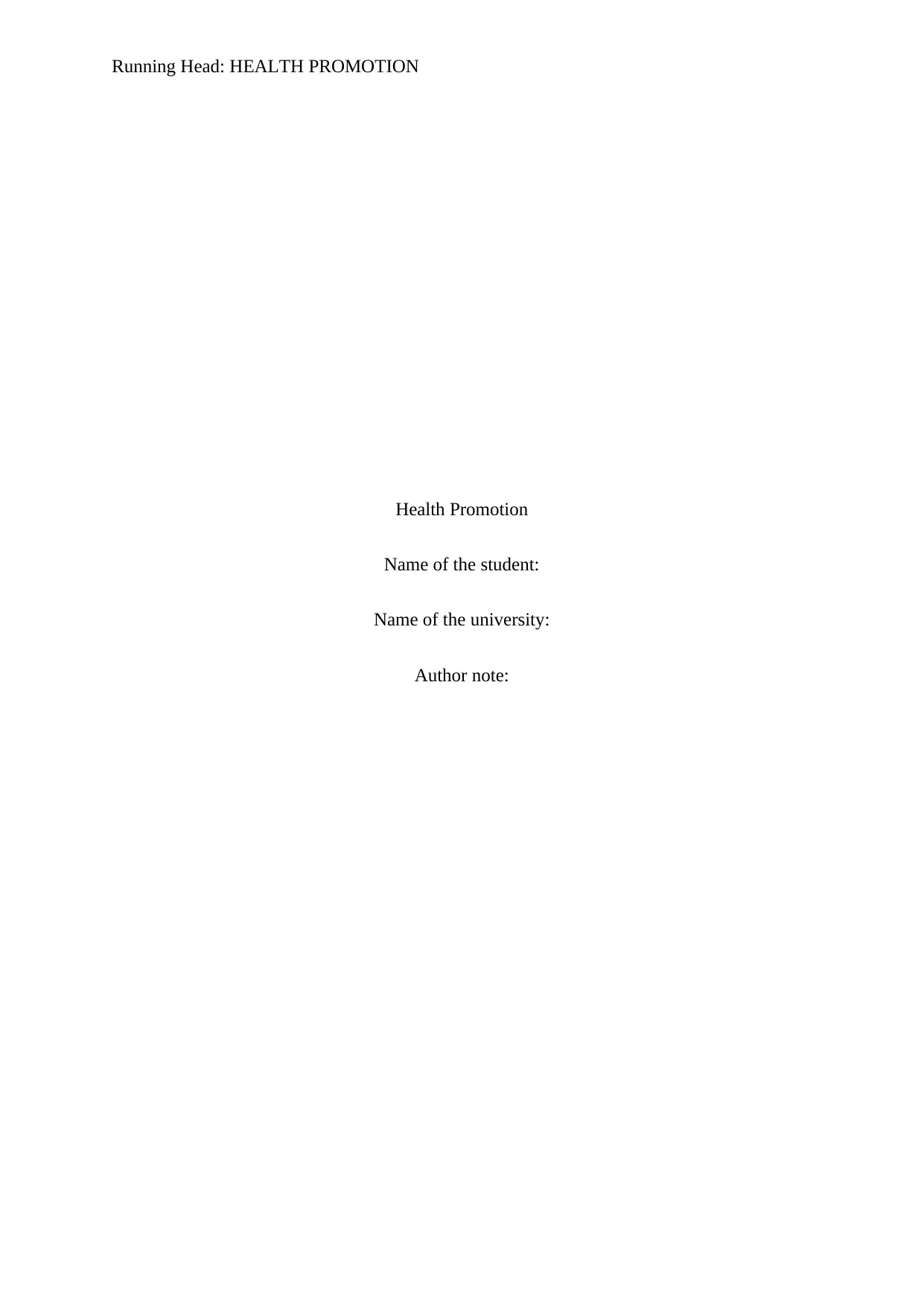
Running Head: HEALTH PROMOTION
Health Promotion
Name of the student:
Name of the university:
Author note:
Health Promotion
Name of the student:
Name of the university:
Author note:
Paraphrase This Document
Need a fresh take? Get an instant paraphrase of this document with our AI Paraphraser
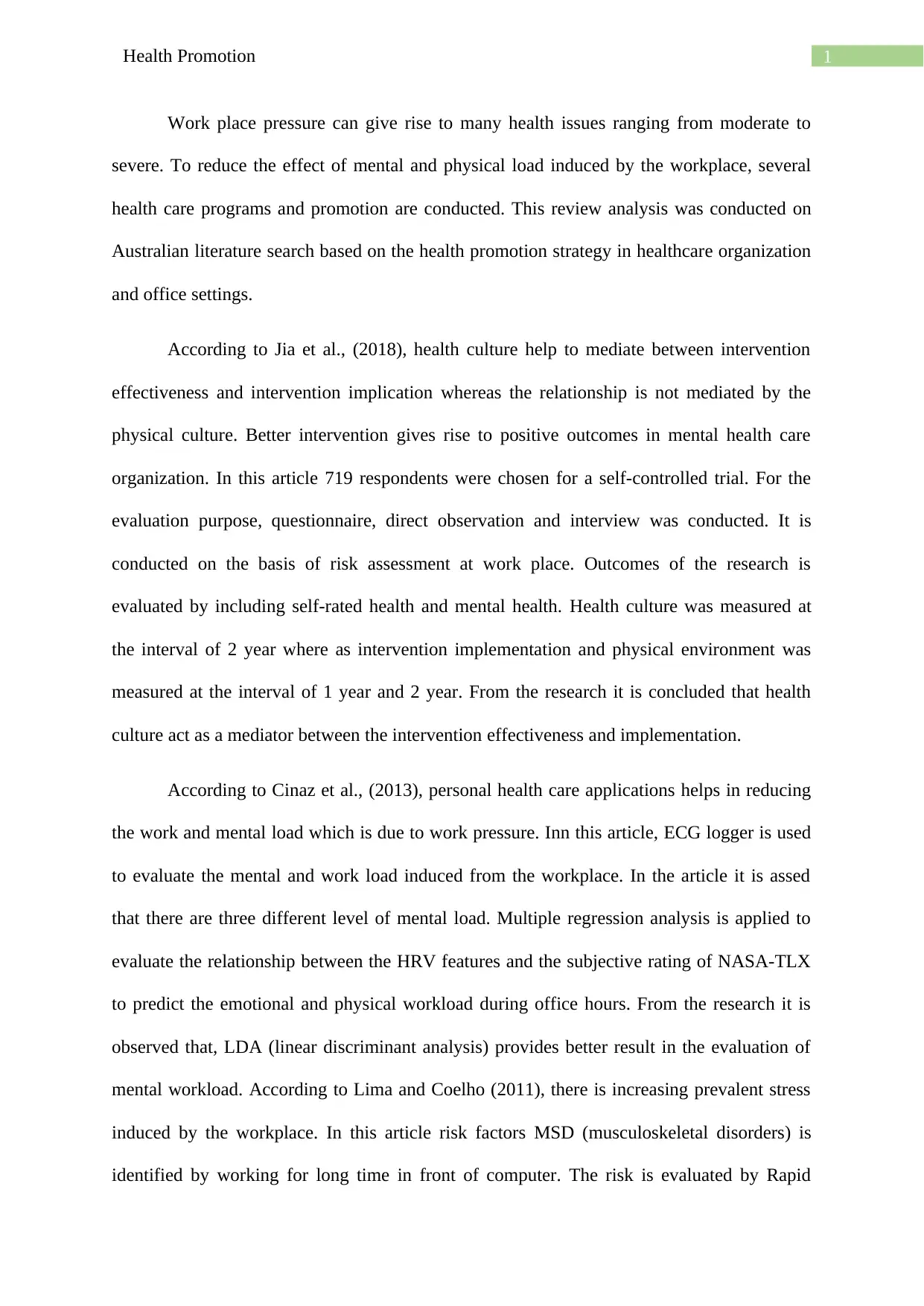
1Health Promotion
Work place pressure can give rise to many health issues ranging from moderate to
severe. To reduce the effect of mental and physical load induced by the workplace, several
health care programs and promotion are conducted. This review analysis was conducted on
Australian literature search based on the health promotion strategy in healthcare organization
and office settings.
According to Jia et al., (2018), health culture help to mediate between intervention
effectiveness and intervention implication whereas the relationship is not mediated by the
physical culture. Better intervention gives rise to positive outcomes in mental health care
organization. In this article 719 respondents were chosen for a self-controlled trial. For the
evaluation purpose, questionnaire, direct observation and interview was conducted. It is
conducted on the basis of risk assessment at work place. Outcomes of the research is
evaluated by including self-rated health and mental health. Health culture was measured at
the interval of 2 year where as intervention implementation and physical environment was
measured at the interval of 1 year and 2 year. From the research it is concluded that health
culture act as a mediator between the intervention effectiveness and implementation.
According to Cinaz et al., (2013), personal health care applications helps in reducing
the work and mental load which is due to work pressure. Inn this article, ECG logger is used
to evaluate the mental and work load induced from the workplace. In the article it is assed
that there are three different level of mental load. Multiple regression analysis is applied to
evaluate the relationship between the HRV features and the subjective rating of NASA-TLX
to predict the emotional and physical workload during office hours. From the research it is
observed that, LDA (linear discriminant analysis) provides better result in the evaluation of
mental workload. According to Lima and Coelho (2011), there is increasing prevalent stress
induced by the workplace. In this article risk factors MSD (musculoskeletal disorders) is
identified by working for long time in front of computer. The risk is evaluated by Rapid
Work place pressure can give rise to many health issues ranging from moderate to
severe. To reduce the effect of mental and physical load induced by the workplace, several
health care programs and promotion are conducted. This review analysis was conducted on
Australian literature search based on the health promotion strategy in healthcare organization
and office settings.
According to Jia et al., (2018), health culture help to mediate between intervention
effectiveness and intervention implication whereas the relationship is not mediated by the
physical culture. Better intervention gives rise to positive outcomes in mental health care
organization. In this article 719 respondents were chosen for a self-controlled trial. For the
evaluation purpose, questionnaire, direct observation and interview was conducted. It is
conducted on the basis of risk assessment at work place. Outcomes of the research is
evaluated by including self-rated health and mental health. Health culture was measured at
the interval of 2 year where as intervention implementation and physical environment was
measured at the interval of 1 year and 2 year. From the research it is concluded that health
culture act as a mediator between the intervention effectiveness and implementation.
According to Cinaz et al., (2013), personal health care applications helps in reducing
the work and mental load which is due to work pressure. Inn this article, ECG logger is used
to evaluate the mental and work load induced from the workplace. In the article it is assed
that there are three different level of mental load. Multiple regression analysis is applied to
evaluate the relationship between the HRV features and the subjective rating of NASA-TLX
to predict the emotional and physical workload during office hours. From the research it is
observed that, LDA (linear discriminant analysis) provides better result in the evaluation of
mental workload. According to Lima and Coelho (2011), there is increasing prevalent stress
induced by the workplace. In this article risk factors MSD (musculoskeletal disorders) is
identified by working for long time in front of computer. The risk is evaluated by Rapid
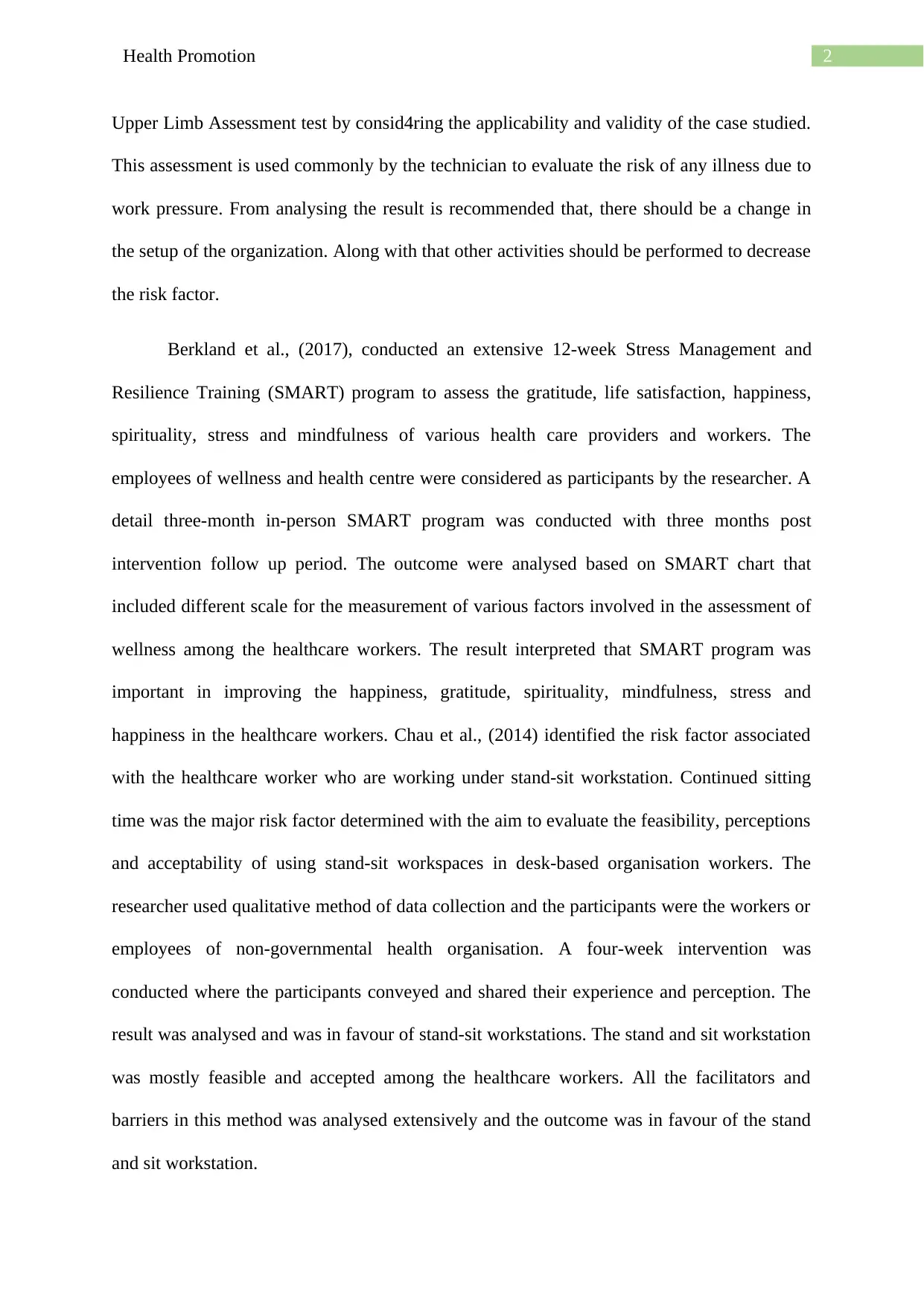
2Health Promotion
Upper Limb Assessment test by consid4ring the applicability and validity of the case studied.
This assessment is used commonly by the technician to evaluate the risk of any illness due to
work pressure. From analysing the result is recommended that, there should be a change in
the setup of the organization. Along with that other activities should be performed to decrease
the risk factor.
Berkland et al., (2017), conducted an extensive 12-week Stress Management and
Resilience Training (SMART) program to assess the gratitude, life satisfaction, happiness,
spirituality, stress and mindfulness of various health care providers and workers. The
employees of wellness and health centre were considered as participants by the researcher. A
detail three-month in-person SMART program was conducted with three months post
intervention follow up period. The outcome were analysed based on SMART chart that
included different scale for the measurement of various factors involved in the assessment of
wellness among the healthcare workers. The result interpreted that SMART program was
important in improving the happiness, gratitude, spirituality, mindfulness, stress and
happiness in the healthcare workers. Chau et al., (2014) identified the risk factor associated
with the healthcare worker who are working under stand-sit workstation. Continued sitting
time was the major risk factor determined with the aim to evaluate the feasibility, perceptions
and acceptability of using stand-sit workspaces in desk-based organisation workers. The
researcher used qualitative method of data collection and the participants were the workers or
employees of non-governmental health organisation. A four-week intervention was
conducted where the participants conveyed and shared their experience and perception. The
result was analysed and was in favour of stand-sit workstations. The stand and sit workstation
was mostly feasible and accepted among the healthcare workers. All the facilitators and
barriers in this method was analysed extensively and the outcome was in favour of the stand
and sit workstation.
Upper Limb Assessment test by consid4ring the applicability and validity of the case studied.
This assessment is used commonly by the technician to evaluate the risk of any illness due to
work pressure. From analysing the result is recommended that, there should be a change in
the setup of the organization. Along with that other activities should be performed to decrease
the risk factor.
Berkland et al., (2017), conducted an extensive 12-week Stress Management and
Resilience Training (SMART) program to assess the gratitude, life satisfaction, happiness,
spirituality, stress and mindfulness of various health care providers and workers. The
employees of wellness and health centre were considered as participants by the researcher. A
detail three-month in-person SMART program was conducted with three months post
intervention follow up period. The outcome were analysed based on SMART chart that
included different scale for the measurement of various factors involved in the assessment of
wellness among the healthcare workers. The result interpreted that SMART program was
important in improving the happiness, gratitude, spirituality, mindfulness, stress and
happiness in the healthcare workers. Chau et al., (2014) identified the risk factor associated
with the healthcare worker who are working under stand-sit workstation. Continued sitting
time was the major risk factor determined with the aim to evaluate the feasibility, perceptions
and acceptability of using stand-sit workspaces in desk-based organisation workers. The
researcher used qualitative method of data collection and the participants were the workers or
employees of non-governmental health organisation. A four-week intervention was
conducted where the participants conveyed and shared their experience and perception. The
result was analysed and was in favour of stand-sit workstations. The stand and sit workstation
was mostly feasible and accepted among the healthcare workers. All the facilitators and
barriers in this method was analysed extensively and the outcome was in favour of the stand
and sit workstation.
⊘ This is a preview!⊘
Do you want full access?
Subscribe today to unlock all pages.

Trusted by 1+ million students worldwide
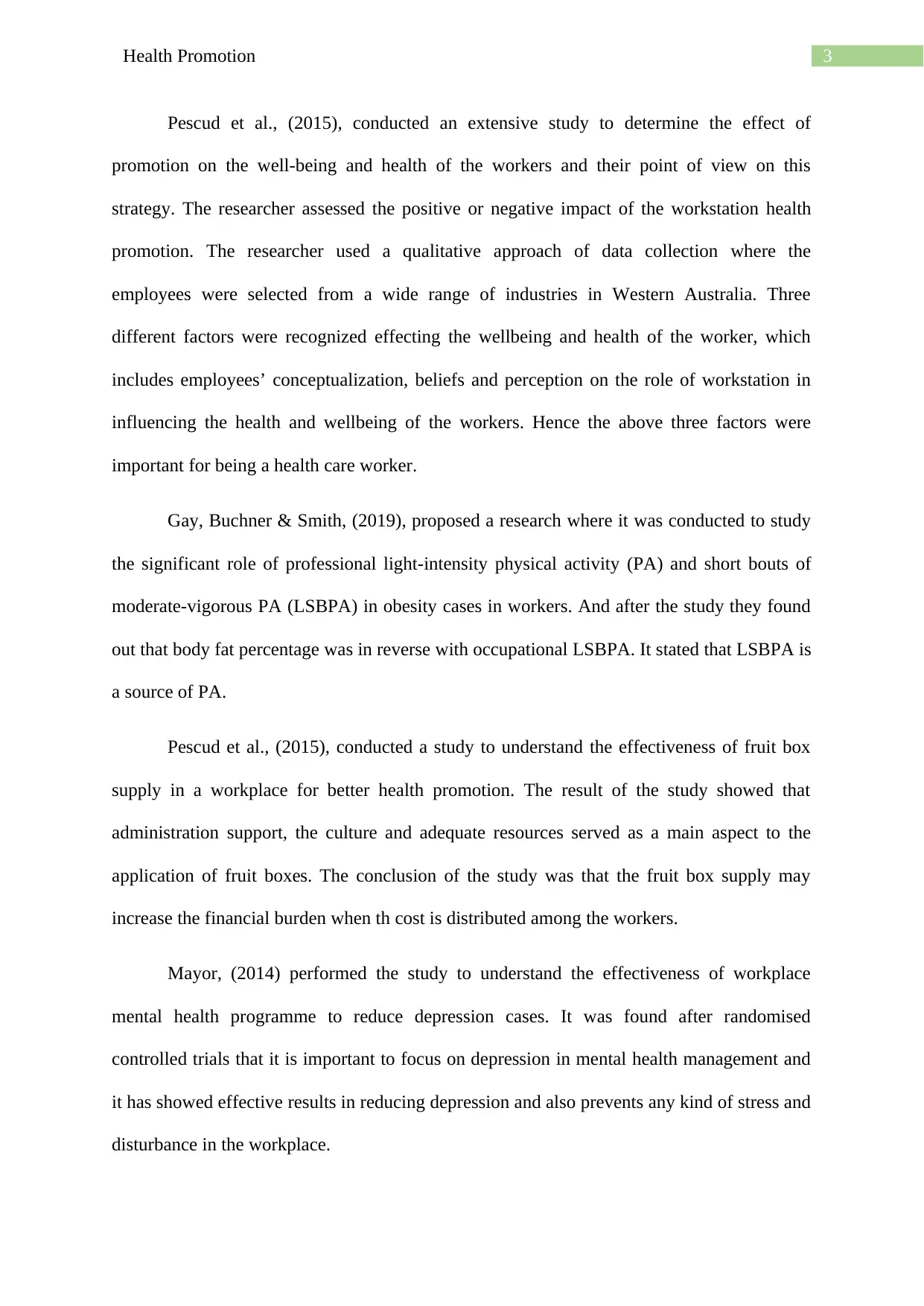
3Health Promotion
Pescud et al., (2015), conducted an extensive study to determine the effect of
promotion on the well-being and health of the workers and their point of view on this
strategy. The researcher assessed the positive or negative impact of the workstation health
promotion. The researcher used a qualitative approach of data collection where the
employees were selected from a wide range of industries in Western Australia. Three
different factors were recognized effecting the wellbeing and health of the worker, which
includes employees’ conceptualization, beliefs and perception on the role of workstation in
influencing the health and wellbeing of the workers. Hence the above three factors were
important for being a health care worker.
Gay, Buchner & Smith, (2019), proposed a research where it was conducted to study
the significant role of professional light-intensity physical activity (PA) and short bouts of
moderate-vigorous PA (LSBPA) in obesity cases in workers. And after the study they found
out that body fat percentage was in reverse with occupational LSBPA. It stated that LSBPA is
a source of PA.
Pescud et al., (2015), conducted a study to understand the effectiveness of fruit box
supply in a workplace for better health promotion. The result of the study showed that
administration support, the culture and adequate resources served as a main aspect to the
application of fruit boxes. The conclusion of the study was that the fruit box supply may
increase the financial burden when th cost is distributed among the workers.
Mayor, (2014) performed the study to understand the effectiveness of workplace
mental health programme to reduce depression cases. It was found after randomised
controlled trials that it is important to focus on depression in mental health management and
it has showed effective results in reducing depression and also prevents any kind of stress and
disturbance in the workplace.
Pescud et al., (2015), conducted an extensive study to determine the effect of
promotion on the well-being and health of the workers and their point of view on this
strategy. The researcher assessed the positive or negative impact of the workstation health
promotion. The researcher used a qualitative approach of data collection where the
employees were selected from a wide range of industries in Western Australia. Three
different factors were recognized effecting the wellbeing and health of the worker, which
includes employees’ conceptualization, beliefs and perception on the role of workstation in
influencing the health and wellbeing of the workers. Hence the above three factors were
important for being a health care worker.
Gay, Buchner & Smith, (2019), proposed a research where it was conducted to study
the significant role of professional light-intensity physical activity (PA) and short bouts of
moderate-vigorous PA (LSBPA) in obesity cases in workers. And after the study they found
out that body fat percentage was in reverse with occupational LSBPA. It stated that LSBPA is
a source of PA.
Pescud et al., (2015), conducted a study to understand the effectiveness of fruit box
supply in a workplace for better health promotion. The result of the study showed that
administration support, the culture and adequate resources served as a main aspect to the
application of fruit boxes. The conclusion of the study was that the fruit box supply may
increase the financial burden when th cost is distributed among the workers.
Mayor, (2014) performed the study to understand the effectiveness of workplace
mental health programme to reduce depression cases. It was found after randomised
controlled trials that it is important to focus on depression in mental health management and
it has showed effective results in reducing depression and also prevents any kind of stress and
disturbance in the workplace.
Paraphrase This Document
Need a fresh take? Get an instant paraphrase of this document with our AI Paraphraser
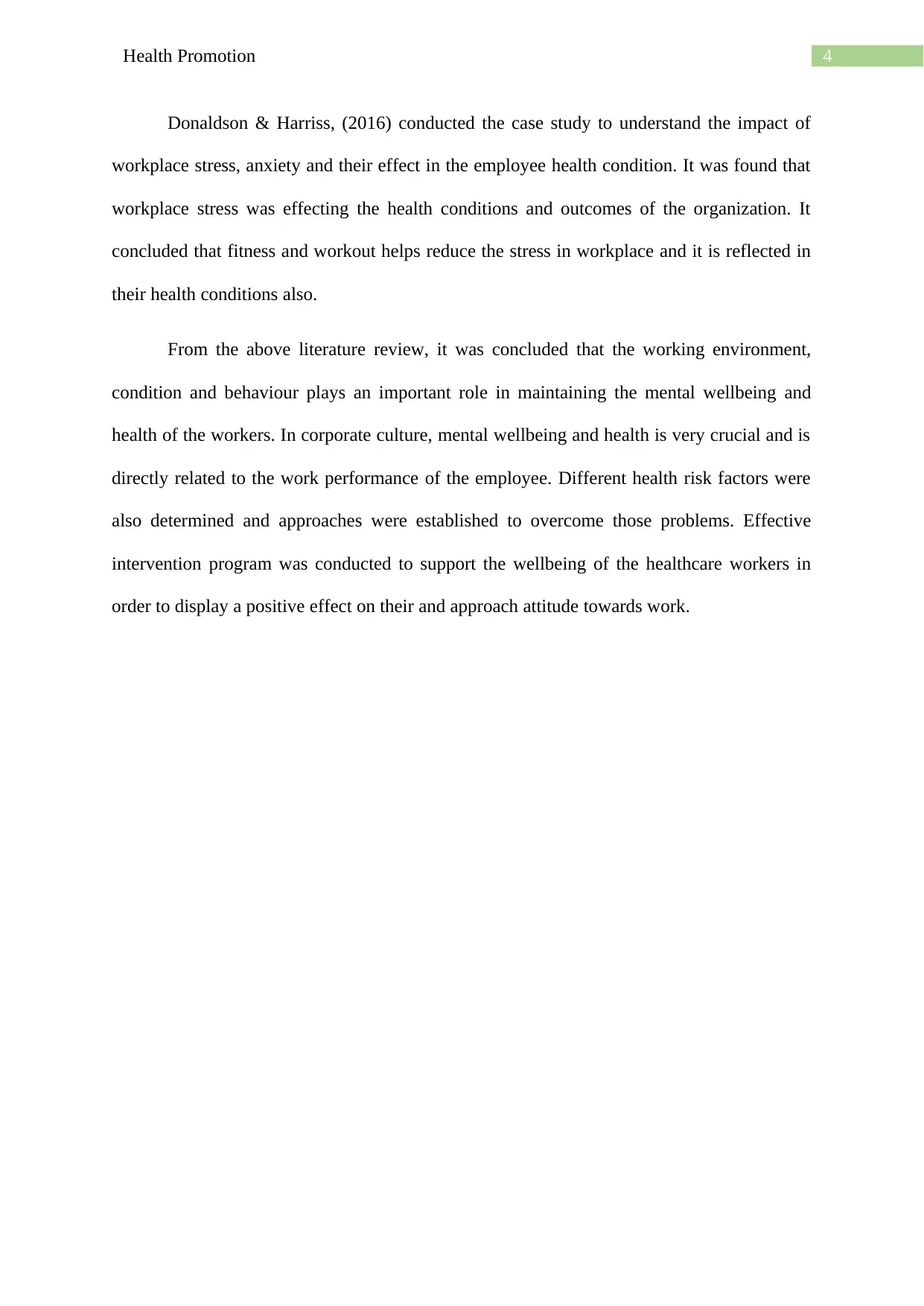
4Health Promotion
Donaldson & Harriss, (2016) conducted the case study to understand the impact of
workplace stress, anxiety and their effect in the employee health condition. It was found that
workplace stress was effecting the health conditions and outcomes of the organization. It
concluded that fitness and workout helps reduce the stress in workplace and it is reflected in
their health conditions also.
From the above literature review, it was concluded that the working environment,
condition and behaviour plays an important role in maintaining the mental wellbeing and
health of the workers. In corporate culture, mental wellbeing and health is very crucial and is
directly related to the work performance of the employee. Different health risk factors were
also determined and approaches were established to overcome those problems. Effective
intervention program was conducted to support the wellbeing of the healthcare workers in
order to display a positive effect on their and approach attitude towards work.
Donaldson & Harriss, (2016) conducted the case study to understand the impact of
workplace stress, anxiety and their effect in the employee health condition. It was found that
workplace stress was effecting the health conditions and outcomes of the organization. It
concluded that fitness and workout helps reduce the stress in workplace and it is reflected in
their health conditions also.
From the above literature review, it was concluded that the working environment,
condition and behaviour plays an important role in maintaining the mental wellbeing and
health of the workers. In corporate culture, mental wellbeing and health is very crucial and is
directly related to the work performance of the employee. Different health risk factors were
also determined and approaches were established to overcome those problems. Effective
intervention program was conducted to support the wellbeing of the healthcare workers in
order to display a positive effect on their and approach attitude towards work.
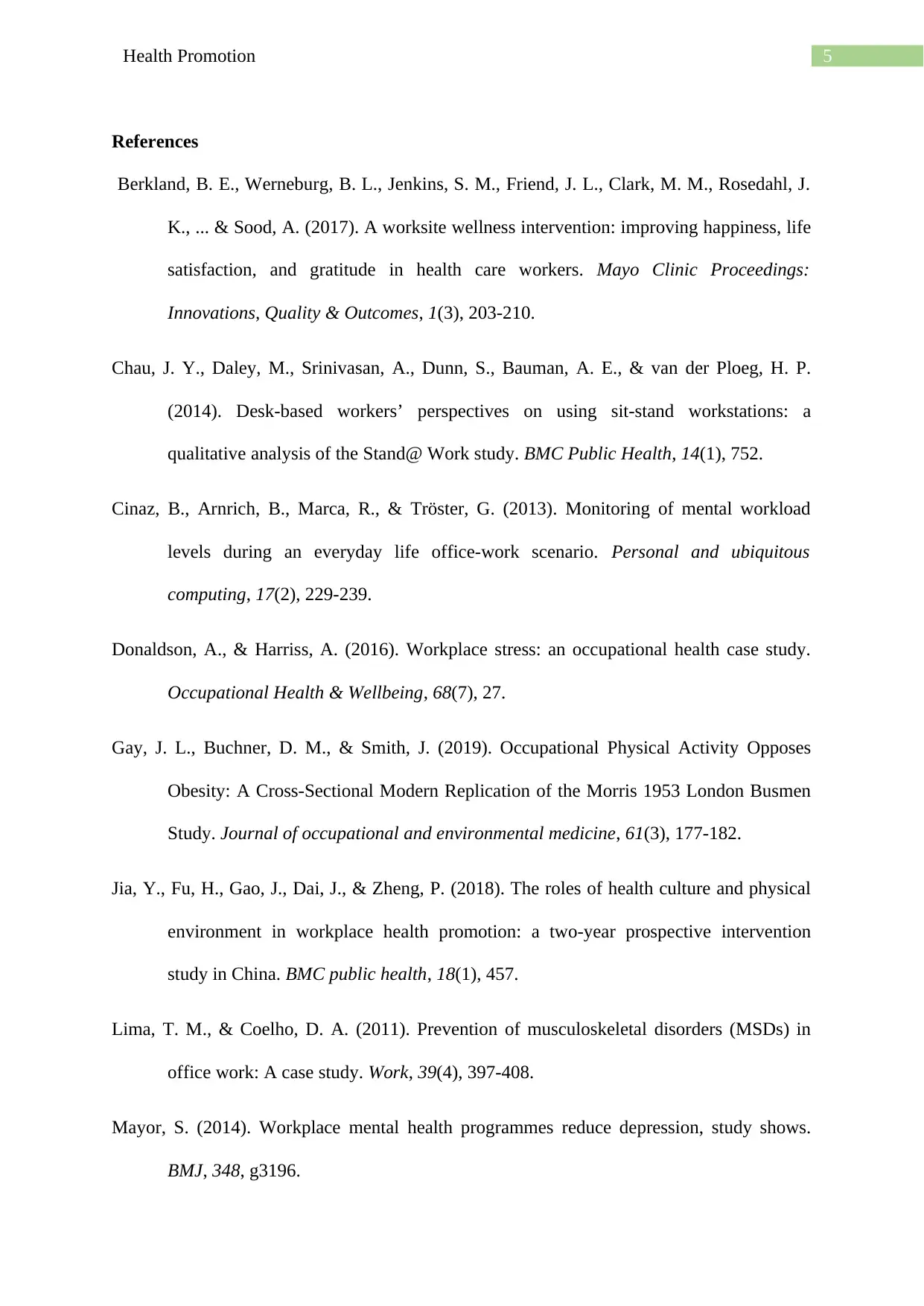
5Health Promotion
References
Berkland, B. E., Werneburg, B. L., Jenkins, S. M., Friend, J. L., Clark, M. M., Rosedahl, J.
K., ... & Sood, A. (2017). A worksite wellness intervention: improving happiness, life
satisfaction, and gratitude in health care workers. Mayo Clinic Proceedings:
Innovations, Quality & Outcomes, 1(3), 203-210.
Chau, J. Y., Daley, M., Srinivasan, A., Dunn, S., Bauman, A. E., & van der Ploeg, H. P.
(2014). Desk-based workers’ perspectives on using sit-stand workstations: a
qualitative analysis of the Stand@ Work study. BMC Public Health, 14(1), 752.
Cinaz, B., Arnrich, B., Marca, R., & Tröster, G. (2013). Monitoring of mental workload
levels during an everyday life office-work scenario. Personal and ubiquitous
computing, 17(2), 229-239.
Donaldson, A., & Harriss, A. (2016). Workplace stress: an occupational health case study.
Occupational Health & Wellbeing, 68(7), 27.
Gay, J. L., Buchner, D. M., & Smith, J. (2019). Occupational Physical Activity Opposes
Obesity: A Cross-Sectional Modern Replication of the Morris 1953 London Busmen
Study. Journal of occupational and environmental medicine, 61(3), 177-182.
Jia, Y., Fu, H., Gao, J., Dai, J., & Zheng, P. (2018). The roles of health culture and physical
environment in workplace health promotion: a two-year prospective intervention
study in China. BMC public health, 18(1), 457.
Lima, T. M., & Coelho, D. A. (2011). Prevention of musculoskeletal disorders (MSDs) in
office work: A case study. Work, 39(4), 397-408.
Mayor, S. (2014). Workplace mental health programmes reduce depression, study shows.
BMJ, 348, g3196.
References
Berkland, B. E., Werneburg, B. L., Jenkins, S. M., Friend, J. L., Clark, M. M., Rosedahl, J.
K., ... & Sood, A. (2017). A worksite wellness intervention: improving happiness, life
satisfaction, and gratitude in health care workers. Mayo Clinic Proceedings:
Innovations, Quality & Outcomes, 1(3), 203-210.
Chau, J. Y., Daley, M., Srinivasan, A., Dunn, S., Bauman, A. E., & van der Ploeg, H. P.
(2014). Desk-based workers’ perspectives on using sit-stand workstations: a
qualitative analysis of the Stand@ Work study. BMC Public Health, 14(1), 752.
Cinaz, B., Arnrich, B., Marca, R., & Tröster, G. (2013). Monitoring of mental workload
levels during an everyday life office-work scenario. Personal and ubiquitous
computing, 17(2), 229-239.
Donaldson, A., & Harriss, A. (2016). Workplace stress: an occupational health case study.
Occupational Health & Wellbeing, 68(7), 27.
Gay, J. L., Buchner, D. M., & Smith, J. (2019). Occupational Physical Activity Opposes
Obesity: A Cross-Sectional Modern Replication of the Morris 1953 London Busmen
Study. Journal of occupational and environmental medicine, 61(3), 177-182.
Jia, Y., Fu, H., Gao, J., Dai, J., & Zheng, P. (2018). The roles of health culture and physical
environment in workplace health promotion: a two-year prospective intervention
study in China. BMC public health, 18(1), 457.
Lima, T. M., & Coelho, D. A. (2011). Prevention of musculoskeletal disorders (MSDs) in
office work: A case study. Work, 39(4), 397-408.
Mayor, S. (2014). Workplace mental health programmes reduce depression, study shows.
BMJ, 348, g3196.
⊘ This is a preview!⊘
Do you want full access?
Subscribe today to unlock all pages.

Trusted by 1+ million students worldwide
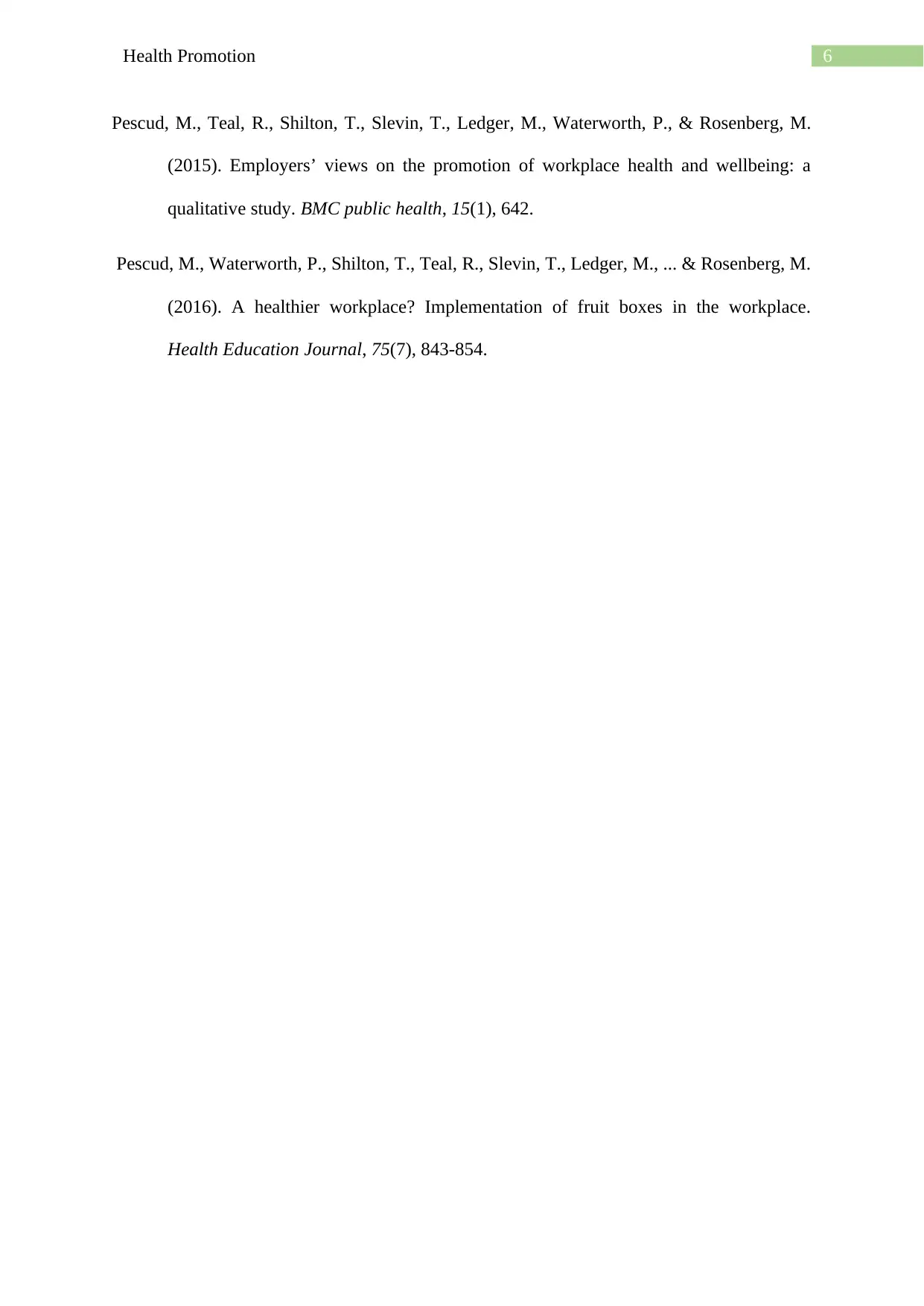
6Health Promotion
Pescud, M., Teal, R., Shilton, T., Slevin, T., Ledger, M., Waterworth, P., & Rosenberg, M.
(2015). Employers’ views on the promotion of workplace health and wellbeing: a
qualitative study. BMC public health, 15(1), 642.
Pescud, M., Waterworth, P., Shilton, T., Teal, R., Slevin, T., Ledger, M., ... & Rosenberg, M.
(2016). A healthier workplace? Implementation of fruit boxes in the workplace.
Health Education Journal, 75(7), 843-854.
Pescud, M., Teal, R., Shilton, T., Slevin, T., Ledger, M., Waterworth, P., & Rosenberg, M.
(2015). Employers’ views on the promotion of workplace health and wellbeing: a
qualitative study. BMC public health, 15(1), 642.
Pescud, M., Waterworth, P., Shilton, T., Teal, R., Slevin, T., Ledger, M., ... & Rosenberg, M.
(2016). A healthier workplace? Implementation of fruit boxes in the workplace.
Health Education Journal, 75(7), 843-854.
1 out of 7
Related Documents
Your All-in-One AI-Powered Toolkit for Academic Success.
+13062052269
info@desklib.com
Available 24*7 on WhatsApp / Email
![[object Object]](/_next/static/media/star-bottom.7253800d.svg)
Unlock your academic potential
Copyright © 2020–2025 A2Z Services. All Rights Reserved. Developed and managed by ZUCOL.





